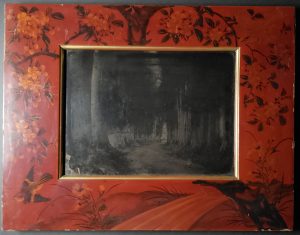Hanbeh (or Hambee) Mizuno was born in Shizuoka on September 1st 1852, the fourth generation of a soy source brewing family. In Meiji 2 (1870) in Yokohama, he learned photography from Shirai, a pupil of famous Renjo Shimo-oka. In Meiji 3 (1871) Mizuno returned to Shizuoka and opened a photographer’s studio. In Meiji 17 (1885) he joined the Farsari Company which was one of the most prominent companies in the making and export of “Yokohama Photos”. Farsari lost its stock of negatives in a fire, and Farsari and Mizuno travelled around Japan to take new photographs for sale.
In Meiji 20 (1888) Mizuno left Farsari to develop his new concept for permanent photographs on his own. At first he pursued photography on porcelain surfaces. However he then turned to the use of the traditional materials of Japanese art including Japanese lacquer, decorated with gold and silver leaf. His first product received an award at an Exhibition held in Meiji 23 (1890). This so-called Makie Photography uses the properties of mixture of potassium bichromate, gum arabic, and honey that is hardened by light by exposure in contact with a negative. Gold flake scattered over the image adheres in proportion to exposure and picture gradation is thus reproduced. Mizuno called the result a Gold Leaf Photograph. It is transferred to the black lacquer ware, covered by thin layer of clear lacquer and polished by the “togidashi” method (the surface is polished using a fine polishing compound).
In Meiji 23 (1890) Mizuno applied for a patent which was granted on 26th December, Meiji 24 (1891). These Makie photographs were exhibited not only in Japan but also in overseas countries such as Columbia, America in 1893; Paris, France in 1900; Porland, America in 1905 – and won many awards. From about Meiji 30 (1897) Mizuno focused his work on the manufacture of Japanese lacquer wares and opened a lacquer production works in Tokyo in Meiji 39 (1906) as well as working as a professional photographer. After his death on June 26th, 1920, Makie photography was continued by his descendants in Shizuoka until about 1965, though no longer as items for sale to tourists. source: refracted.net




